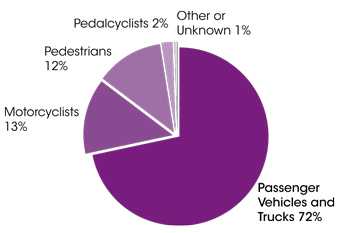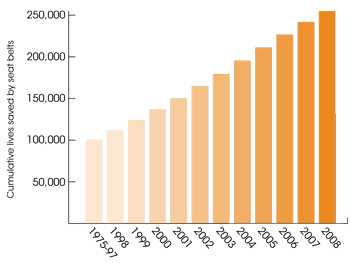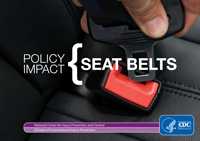Policy Impact: Seat Belts
Historical Document
This web page is provided for reference purposes only. The most current CDC data can be found on the Seat Belts: Get the Facts page. The Insurance Institute for Highway Safety maintains current information about state laws, who they cover, and fines.
Download
Policy Impact: Seat Belts (January 2011)
What's the Issue?
Motor vehicle crashes are the leading cause of death in the first three decades of American’s lives. In 2009 alone, crashes killed over 33,000 people and injured another 2.2 million—more than 70% of these were in passenger vehicles and trucks.1
More than half of the people killed in car crashes were not restrained at the time of the crash.1 Wearing a seat belt is the most effective way to prevent death and serious injury in a crash.
Seat belt use is on the rise. Laws, education, and technology have increased seat belt use from 11% in 19812 to nearly 85% in 20103, saving hundreds of thousands of lives. Yet, about 1 in 7 people still don’t buckle up.
There are proven policies to increase seat belt use and save lives.
In 2009, more than 90 people died in motor vehicle crashes every day.1
What Do We Know?
- Most drivers and passengers killed in crashes are unrestrained. 53% of drivers and passengers killed in car crashes in 2009 were not wearing restraints.1
- Seat belts dramatically reduce risk of death and serious injury. Among drivers and front-seat passengers, seat belts reduce the risk of death by 45%, and cut the risk of serious injury by 50%.4
- Seat belts prevent drivers and passengers from being ejected during a crash. People not wearing a seat belt are 30 times more likely to be ejected from a vehicle during a crash. More than 3 out of 4 people who are ejected during a fatal crash die from their injuries.5
- Seat belts save thousands of lives each year, and increasing use would save thousands more. Seat belts saved almost 13,000 lives in 2009. If all drivers and passengers had worn seat belts that year, almost 4,000 more people would be alive today.6
These facts show that increasing seat belt use is critical to reduce injury and saving lives.
Most People Killed in Crashes are Drivers or Passengers1

Seat Belts Have Saved an Estimated 255,000 Lives Since 19755

In one year alone, crash deaths and injuries to drivers and passengers cost $70 billion in medical and lost work costs.7
What Can We Do?
Seat belts protect people from needless death and injury. But whether it is because they are in a hurry, distracted, or they simply forget, many people don’t wear their seat belts, and thousands die as a result. CDC recommends effective, well-enforced seat belt laws to ensure that every person in every seat buckles up on every trip.
Primary enforcement states have seat belt use 9 percentage points higher than secondary states.8
CDC Recommendations
Primary enforcement seat belt laws
Laws requiring seat belt use are either “primary” or “secondary” enforcement laws. Primary enforcement laws allow police officers to pull over drivers and issue tickets just because the drivers—or their passengers— aren’t wearing seat belts. Secondary enforcement laws only allow police officers to issue tickets for seat belt violations if drivers have been pulled over for some other offense.
Secondary enforcement significantly limits the ability of officers to enforce seat belt laws. Rates of seat belt use are 9 percentage points higher in primary enforcement states than secondary states.8
If the overall prevalence of seat belt use in states with secondary enforcement laws had matched the higher prevalence in states with primary laws, an additional 7.3 million adults would have buckled up in 2008.8 Increasing the number of states with primary enforcement seat belt laws covering all positions will increase seat belt use and save lives.
Enhanced enforcement of existing seat belt laws
“Enhanced enforcement” programs seek to better support seat belt laws by either increasing the average number of citations each officer issues or by increasing the number of officers on patrol. These measures are supported by publicity campaigns, like the successful “Click It or Ticket” initiative.
Research has shown that enhanced enforcement programs increase seat belt use by a median of 16 percentage points.9 Communities that follow this model and implement these programs will increase seat belt use.
Enhanced enforcement increases seat belt use by a median of 16 percentage points.9
Nineteen States Still Lack a Primary Enforcement Seat Belt Law
(Last updated December 2010)
The Insurance Institute for Highway Safety maintains current information about state laws, who they cover, and fines.
References
- Dept of Transportation (US), National Highway Traffic Safety Administration (NHTSA). Traffic Safety Facts: Highlights of 2009 Motor Vehicle Crashes. Washington (DC): NHTSA; 2010. Available at URL: http://www-nrd.nhtsa.dot.gov/Pubs/811363.pdf
- CDC. Achievements in public health, 1900-1999 motor-vehicle safety: a 20th century public health achievement. MMWR 1999;48:369-74.
- Dept of Transportation (US), National Highway Traffic Safety Administration (NHTSA). Traffic Safety Facts: Seat Belt Use in 2010—Overall Results. Washington (DC): NHTSA; 2010. Available at URL: http://www-nrd.nhtsa.dot.gov/Pubs/811378.pdf
- Dept of Transportation (US), National Highway Traffic Safety Administration (NHTSA). Traffic Safety Facts: Children. Washington (DC): NHTSA; 2010. Available at URL: http://www-nrd.nhtsa.dot.gov/Pubs/811387.pdf
- Dept of Transportation (US), National Highway Traffic Safety Administration (NHTSA). Traffic Safety Facts: Occupant Protection. Washington (DC): NHTSA; 2009. Available at URL: http://www-nrd.nhtsa.dot.gov/Pubs/811160.pdf
- Dept of Transportation (US), National Highway Traffic Safety Administration (NHTSA). Lives Saved in 2009 by Restraint Use and Minimum-Drinking-Age Laws. Washington (DC): NHTSA; 2010. Available at URL: http://www-nrd.nhtsa.dot.gov/Pubs/811383.pdf
- Naumann RB, Dellinger AM, Zaloshnja E, Lawrence BA, Miller TR. Incidence and total lifetime costs of motor vehicle-related fatal and nonfatal injury by road user type, United States, 2005. Traffic Injury Prev 2010;11:353–360.
- Beck LF, West BA. Vital Signs: Motor Vehicle Occupant Nonfatal Injuries (2009) and Seat Belt Use (2008) Among Adults—United States. Centers for Disease Control and Prevention. 2011.
- Guide to Community Preventive Services. Use of Safety Belts: Enhanced Enforcement Programs. [cited 2010 Nov 24]. Available at URL: http://www.thecommunityguide.org/mvoi/safetybelts/enforcementprograms.html
- Dept of Transportation (US), National Highway Traffic Safety Administration (NHTSA). Traffic Tech: Primary laws and fine levels are associated with increases in seat belt use. Washington (DC): NHTSA; 2010. Available at URL: http://www.nhtsa.gov/staticfiles/traffic_tech/TT400.pdf
Policy Impact
Policy Impact is a series of issue briefs from CDC’s Injury Center highlighting key public health issues and important, science-based policy actions that can be taken to address them.
Related Pages
- Seat Belts: Get the Facts
- Buckle Up: Restraint Use State Fact Sheets
- Restraint Use and Motor Vehicle Occupant State Data
- Seat Belt Use US Map
- Child Passenger Safety
- State-Based Motor Vehicle Data & Information
-
data.cdc.gov
View and download dozens of motor vehicle datasets and visualizations, including charts and maps, on data.cdc.gov.
-
Motor Vehicle Prioritizing Interventions and Cost Calculator for States (MV PICCS)
CDC offers a new interactive calculator to help state decision makers prioritize and select from a suite of 14 effective motor vehicle injury prevention interventions. MV PICCS is designed to calculate the expected number of injuries prevented and lives saved at the state level and the costs of implementation, while taking into account available resources.
-
CDC's Safe Driving Board on Pinterest
Help spread the word about the dangers of drunk driving. Visit the CDC Safe Driving Pinterest board for ready-to-share graphics and social media content.
- Page last reviewed: January 3, 2011
- Page last updated: January 21, 2014
- Content source:
- Centers for Disease Control and Prevention,
- National Center for Injury Prevention and Control,
- Division of Unintentional Injury Prevention


 ShareCompartir
ShareCompartir


